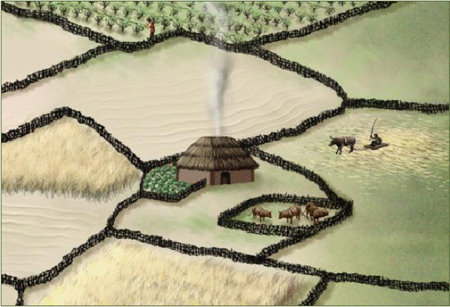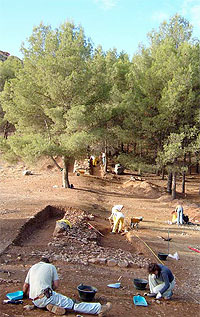
Introduction
Although first experiences of historical analysis of bioarchaeological remains from southern European medieval sites were done at least in the 70s, this type of studies keeps being episodic and very specific. Therefore, the contribution of bioarchaeological disciplines to the understanding of past societies is still biased. The backwardness compared to other European countries or to Prehistoric archaeology is evident. The interpretation of basic subjects of historical landscapes, productive practices and social dynamics is made on the basis of textual documentation or of the reflection of these aspects on the archaeology of sites and monuments. Nevertheless, in the last years, the number of specialists and researchers who study historical societies has been increased and, as a consequence, a significant amount of data and studies has come to light, although these works are generally dispersed and the lack of syntheses is remarkable.
The aims of this conference are, on the one hand, to elaborate regional syntheses about the articulation of early medieval landscapes in Spain on a European context, and on the other hand, to analyse farming and animal husbandry practices in the Early Middle Ages using bioarchaeological remains from Spain and other European regions. Thus, we pretend to re-think the social history of the Early Middle Ages from a perspective that appreciates the diversity and dynamism of peasant communities, unlike the primitive approaches that are still predominant for the characterization of these groups.
To do so, some of the most renowned European specialists have been invited to take part in the conference, having the disciplinary diversity as a priority. Young researchers will also participate in the congress. In addition, we plan to organise a poster session in order to welcome specific studies on these matters.
Program – Programa – Egitaraua
Día 15 noviembre / Azaroaren 15ean / November 15th
9.00 Saludo de autoridades / Agintarien agurra / Authorities’ welcome
9,15 Presentación e introducción / Aurkezpena eta hitzaurrea / Presentation and
introduction. Juan Antonio Quirós (UPV-EHU)
1ª Sesión, modera / 1. saioa, moderatzailea / 1st session,
moderates:
Julio Escalona (CSIC)
9,30 Archaeofauna in Early Medieval England. Terry O’Connor (University of York)
10,10 Gli animali nell’economia e nell’alimentazione dell’Italia altomedievale.
Suggestioni Archeozoologiche. Frank Salvadori (University of Siena)
10,50 Descanso / Atsedenaldia / Break
11,20 Animal husbandry practices in the Iberian Peninsula during the Early Middle Ages. Marta Moreno (CSIC)
12,00 Zooarchaeology of the Early Medieval Basque Country. Idoia Grau (UPV-EHU)
12,40 Discusión / Eztabaida / Discussion
13,00 Comida / Bazkaria / Lunch
2ª sesión, modera / 2. saioa, moderatzailea / 2nd session,
moderates:
Lydia Zapata (UPV-EHU)
15,30 Environmental and land-use changes during early medieval period in
Southwestern France: new insights from palaeoecological records. Didier Galop (Universitè de Tolouse-Le Mirail)
16,10 Natural resources, land uses and landscape zapping in the Iberian Peninsula from Roman to Medieval times: historical palaeoenviromental data. Santiago Riera (Universitat de Barcelona)
16,50 Descanso / Atsedenaldia / Break
17,20 El paisaje vegetal de la Alta Edad Media en el País Vasco a través de los análisis paleopalinológicos. Begoña Hernández (UPV-EHU)
18,00 Discusión / Eztabaida / Discussion
18,20 Sesión de poster/ Poster Saioa/ Poster session
Día 16 noviembre / Azaroaren 16an / November 16th
3ª sesión, modera / 3. saioa, moderatzailea / 3rd session,
moderates:
Mª José Iriarte (UPV-EHU)
9,00 Middle ages climatic changes from terrestrial archives in the Mediterranean. Giovanni Zanchetta (Università degli Studi di Pisa)
9,40 Archaeobotanical light on early medieval farming in France.Marie-Pierre Ruas (CNRS)
10,20 Descanso / Atsedenaldia / Break
11,00 Farming in Early Medieval Italy. Mauro Rottoli (Museo di Como)
11,40 Exploring Medieval Farming: Archaeobotanical data from the Iberian Peninsula. Itsaso Sopelana (UPV-EHU), Lydia Zapata (UPV-EHU), Leonor Peña (CSIC)
12,20 Descanso / Atsedenaldia / Break
12,30 Discusión / Eztabaida / Discussion
13,00 Conclusión / Ondorioak / Conclusion. Pam Crabtree (New York University), Margarita Fernández Mier (Universidad de León)
LIST OF POSTERS:
“Consumption and household processing of vegetal products at the Catalan cities of Islamic period: Madina Balagi, Madina Larida and Madina Turtuxa. X-XIIth centuries AD.” N. Alonso, F. Antolín, C. Alòs, H. Kirchner, A. Loriente, E. Solanes
“Cereal consumption in early medieval Cantabria (7th – 8th centuries AD): making the dead talk” P. Arias Cabal, E. Gutiérrez Cuenca, J.Á. Hierro Gárate, I. López López-Dóriga
“The exploitation of animal resource in Apulia from 10th to 11st centuries A.D.: the zooarchaeology contribution” A. Buglione, G. De Venuto
“The sheep/goat transhumant breeding in Northern Apulia from Late Antiquity to the Early Middle Ages: a zooarchaeological approach” A. Buglione
“Animal Husbandry in East Anglia from the 5th to the 10th Centuries CE” P. Crabtree
“Registro paleoambiental y arqueozoológico en una aldea medieval: Villanueva de Santo Adriano (Asturias, Spain)” J. Fernández Fernández, M. Moreno García
“Zooarqueología de dos yacimientos con ocupaciones tardoantiguas y altomedievales de la provincia de León (noroeste de la Península Ibérica)” C. Fernández Rodríguez, J.C. Alvarez García, V. Bejega García, Mª N. Fuertes Prieto, E. González Gómez de Agüero
“Faunal remains from Madinat Ilbira (Granada). Zooarchaeological study of a medieval Islamic town in southern Spain” M. G. García
“Variation in Animal Consumption at Medieval Villamagna” E. Holt
“Animal husbandry on Polish territory in the Early Middle Ages” U. Iwaszczuk
“Ganadería y alimentación en los siglos IV-VI en Graccurris” E. Lladó Aguillo, P. del Fresno Bernal y J. M. Martínez Torrecilla
“Unimproved early medieval sheep in Northern Iberia: an archaeozoological and actualistic approach” L. Llorente, A. Morales, M. Moreno
“Miranduolo: a farm-village in the southern Tuscany” M. Putti
“Crops and agriculture during the Early Middle Ages in northern Catalunya (Pyrénées-Orientales, France)” J. Ros, M.-P. Ruas
“Domestic mammals in Eastern Romania during Early Middle Ages” S. Stanc, L. Bejenaru
“Woodlands East and Hallahoise: A case of Irish Early Medieval husbandry specialization” C. Tommasino
“Terrazas en el entorno de Santa Juliana de Abanto-Zierbena (Bizkaia)” R. Varón, J.Á. Fernandez, B. Hernandez, I. Sopelana
More information:
https://sites.google.com/site/farmingandhusbandry/home







